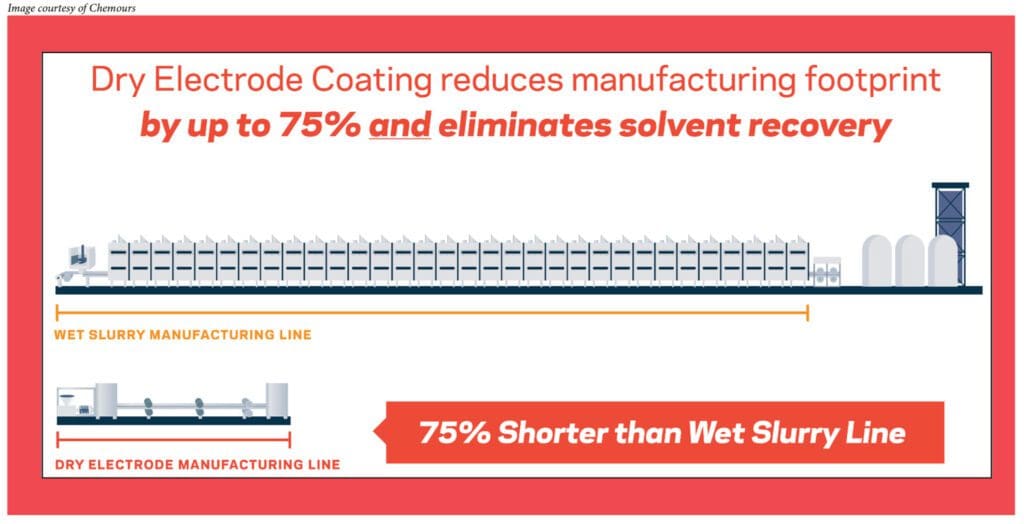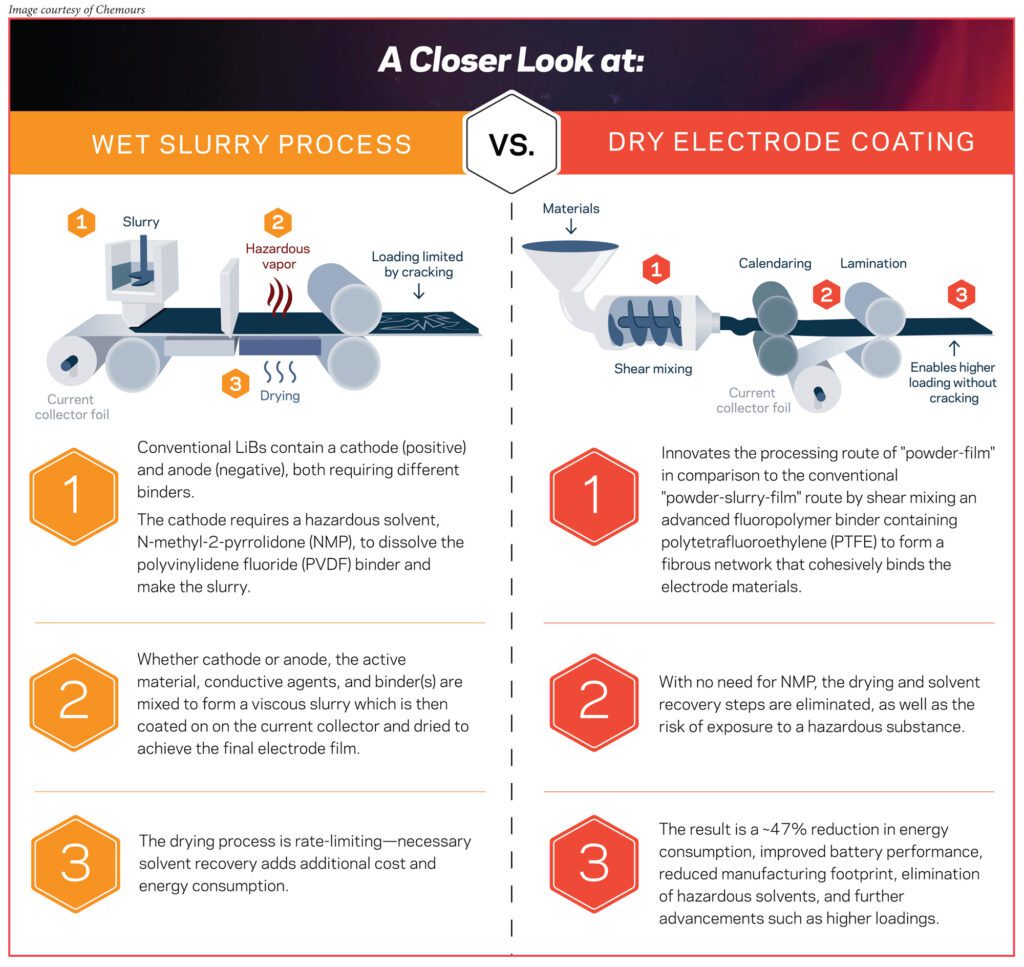The dry electrode coating course of has the potential to allow the manufacturing of higher, greener, more cost effective batteries. It depends on superior fluoropolymer binders with Teflon™
For a couple of years now, Charged has been reporting on how dry electrode coating processes have the potential to revolutionize battery manufacturing by eliminating using hazardous, environmentally dangerous solvents. Taking the solvents out of the method can translate to massive financial savings in price and ground area within the manufacturing facility—and the dry coating course of may also allow designers to enhance battery efficiency.
The dry electrode coating course of depends on using particular binders that may type an electrode coating with out being dissolved in a solvent, comparable to fluoropolymer binders with Teflon™ from specialty chemical firm Chemours.
To find out about some great benefits of the dry coating course of, and the way firms are assembly the challenges concerned in scaling the know-how up from pilot to manufacturing scale, Charged spoke with Tejas Upasani, International EV Know-how Supervisor at Chemours.
Tejas Upasani: We prefer to name Chemours “a startup firm with 200 years of historical past.” We spun out of DuPont in 2015, and now we have main manufacturers in numerous industries, together with semiconductors and automotive. Underneath our Superior Efficiency Supplies enterprise, now we have manufacturers you would possibly acknowledge, comparable to Teflon™, Nafion™ and Viton™.
Now we’re experiencing progress in our merchandise in a brand-new subject—the dry electrode coating course of—and I’m actually excited to see how Chemours can assist the scale-up of this new utility.
Within the dry course of, most of the substances stay the identical—comparable energetic supplies, comparable conductive components. What actually adjustments is the binder.
Charged: Are you able to stroll us by way of the fundamental benefits of the dry electrode coating course of versus the normal moist slurry-based course of?
Tejas Upasani: The dry coating course of is a novel approach of producing cathode and anode electrodes in lithium batteries.
Within the conventional moist slurry course of, now we have the energetic substances, now we have the conductive components, and we use a selected binder which must be dissolved in a solvent. As soon as all these substances are blended collectively, we create what is known as a slurry. That slurry needs to be coated onto a present collector. At that time, the perform of the solvent is finished, so we dry off the solvent and we get a pleasant coating on the present collector.

Within the dry course of, most of the substances stay the identical—comparable energetic supplies, comparable conductive components. What actually adjustments is the binder. On this case, we’ll be utilizing superior fluoropolymer binders with Teflon™ which, due to its distinctive properties, doesn’t must be dissolved in any solvent. It may possibly type the coating because it goes by way of the processing steps by way of a course of known as fibrillation, which mainly varieties all the coating on the present collector.
Why is the dry course of advantageous over the moist slurry course of? We are able to have a look at this from three totally different angles.
One is that it’s rather more environmentally pleasant. The moist slurry course of makes use of NMP [N-Methylpyrrolidone], which is a hazardous solvent. As a way to eliminate the solvent within the moist slurry course of, it has to undergo a sequence of ovens. If there isn’t a want for the solvent, then the hazards related to the solvent are eliminated.
The second half is manufacturing prices. Should you have a look at how a lot area is required for the moist slurry course of, by some estimates, it’s 10 occasions the area in comparison with the dry course of, so there’s an amazing quantity of financial savings of ground area that may be achieved with the dry course of.
The third side is that it allows higher efficiency of the batteries. With the dry course of, we will make thicker electrodes, which may also help with bettering energy density.
Superior fluoropolymer binders from Chemours are actually on the coronary heart and middle of that course of.
Charged: Is that this one thing that might assist to cut back charging occasions?
Tejas Upasani: It probably might. There’s a number of testing that’s being finished proper now, evaluating the moist slurry course of and the dry course of. If you’ll be able to go to a better loading with the dry electrode course of—say, all the best way to eight or 9 milliamp-hours per sq. centimeter—we will see aggressive or increased charging charges in comparison with a standard loading of the moist slurry course of, which is about 3 to 4 milliamp-hours per sq. centimeter now. A lot of this work is finished at lab scale or pilot scale, however because the know-how matures and we begin seeing higher course of applied sciences, these could be realized in real-life eventualities as effectively.
Charged: Is dry electrode coating presently in manufacturing?
Tejas Upasani: We’re within the early levels of the event course of. Some {industry} gamers are at manufacturing scale. For instance, on Battery Day in 2020, Tesla introduced that they wished to supply their 4680 cells in a dry electrode course of. And on Investor Day in 2023, the corporate introduced that they’d efficiently carried out industrial manufacturing of the dry electrode course of. PowerCo, a subsidiary of Volkswagen, has introduced that they may deploy and commercialize the dry electrode course of at many alternative areas. LG Power Options has introduced comparable plans.
However because it stands proper now, we’re seeing all the spectrum—lab, pilot, pre-production, manufacturing—of adoption of the dry electrode course of.
We expect that cell producers and OEMs within the subsequent two to 5 years are going to be in several levels. Some are going to be at pilot scale. Others are going to advance into manufacturing scale. However because it stands proper now, we’re seeing all the spectrum—lab, pilot, pre-production, manufacturing—of adoption of the dry electrode course of.
Charged: Are there any main technical hurdles that we nonetheless have to get previous earlier than this may be broadly adopted?
Tejas Upasani: Actually there are hurdles. Everyone’s attempting to develop the method, they usually’re attempting to make it possible for the proper mixing and calendaring could be finished so as to create a uniform construction. Among the technical hurdles need to do with binders and the dry electrode processes enabled by way of understanding the fibril community of PTFE [polytetrafluoroethylene].
Using PTFE and the resultant fibril community has been understood for many years, and we, as inventors of PTFE, have invested a number of science behind understanding the fibril community, however it usually has been utilized to industries the place PTFE is the dominant element within the utility. For instance, when you have a look at your commonplace plumber’s tape (Teflon™ tape), it makes use of precisely the identical precept of fibrillation. That’s why you possibly can pull it in a single path simply, however within the transverse path, you possibly can simply break it aside.
It’s the identical on this utility—we’re attempting to manage the fibrillation by way of the blending course of and thru the calendaring course of. Chemours has invested closely in growing numerous varieties of superior fluoropolymer binders with PTFE. These have a spread of various molecular weights and totally different polymer architectures, and all of those are meant to allow the correct fibrillation traits inside the electrode course of.
On the cathode aspect, usually PTFE is oxidatively very secure…it’s a really promising utility. On the anode aspect there could be reductive stability challenges related to conventional PTFE, and so utilizing conventional PTFEs may not be the optimum resolution.
Conventional PTFE might have challenges on the anode aspect. On the cathode aspect, usually PTFE is oxidatively very secure. One of many benefits is you can go to increased voltages and it nonetheless is secure at higher-voltage purposes. So, on the cathode aspect, it’s a really promising utility.
On the anode aspect there could be reductive stability challenges related to conventional PTFE, and so utilizing conventional PTFEs may not be the optimum resolution. That’s one of many explanation why we’re growing a number of totally different merchandise and attempting to know the mechanism of why conventional PTFE just isn’t secure on the anode aspect. And as soon as we perceive that mechanism, how will we remedy that? There’s an amazing quantity of labor happening internally and with our exterior companions as effectively to try to perceive and remedy these hurdles.
Charged: One of many challenges is adhesion. The dry materials has to bond to the electrode floor, however the flat floor and lack of texture could make that troublesome.
Tejas Upasani: The {industry} proper now could be utilizing what we name carbon-coated present collectors. They’ve sure coatings on the present collectors, and when the dry course of movies are made, these get laminated onto that carbon-coated present collector.
That’s the answer that the {industry} has at this level, and it’s working pretty effectively in each anode and cathode processes. Now, if we wished to instantly laminate the movie onto the present collector with none carbon coating, then that’s slightly little bit of an issue, and we’re engaged on it proper now.
We’re ways in which we will alter the chemistry of the polymers themselves so as to get higher adhesion to the present collectors. If we have been in a position to instantly laminate onto the present collector, why have this carbon coating?
We’re ways in which we will alter the chemistry of the polymers themselves so as to get higher adhesion to the present collectors. If we have been in a position to instantly laminate onto the present collector, why have this carbon coating? Eliminating the coating reduces the associated fee. I feel which may come, however proper now the main focus is on scaling up the know-how with coated present collectors.
Charged: The method wants to cut back the quantity of binder and different inactive materials to an identical stage as that of moist coating, however this may be costly and exhausting to scale up.
Tejas Upasani: Yeah. Sure cell chemistries require growing the quantity of inactive materials, particularly on the cathode aspect, whereas there are some cell chemistries the place we’re binder loadings of lower than 2%, and in some circumstances even lower than 1%.
So, it’s already being labored on, attempting to cut back the quantity of inactive supplies. It does require a number of course of optimization as a result of, as you possibly can think about, the small quantity of binder is holding up all the powder chemistry. So, a number of course of know-how, together with the fabric enhancements that we’re doing in growing new supplies and arising with totally different polymer chemistries, goes to allow even additional reductions of the quantity of inactive supplies.
Charged: One other problem is uniformity—the dry coating combination must be uniform throughout massive areas of the battery electrodes.
Tejas Upasani: I don’t assume uniformity challenges are essentially restricted to the dry coating course of. There are strategies which were developed within the moist slurry course of to know that the viscosity is true or the solids content material is true, and that may assist us to know that the uniformity of the slurry can be good.
As soon as the blending is finished homogeneously, the great thing about the dry electrode course of is that, as soon as it’s laminated onto the present collector, the coating course of is finished. You don’t have any motion or settling of the substances.
Within the dry course of, it’s comparable, besides that we’re coping with all of the powders. There are analytical strategies and instruments which might be being developed so as to confirm that these powders are blended appropriately—the energetic supplies, carbon black and binders, they must be blended actually homogeneously. As soon as the blending is finished homogeneously, the great thing about the dry electrode course of is that, as soon as it’s laminated onto the present collector, the coating course of is finished. You don’t have any motion or settling of the substances. In a moist slurry course of, when you have been to make a thick electrode, because the solvent is drying off, these substances might begin to settle in the course of the drying course of.
Charged: So, your organization would accomplice with the producer to find out the perfect combine.
Tejas Upasani: Sure. And all through our historical past, now we have checked out utility improvement. That is what now we have finished at Chemours for many years. We don’t need to simply say to the shoppers, “Right here’s a cloth, use it.” We don’t need to say that we’re only a provider. We don’t need to cease there. We need to make it possible for we contribute to the success of our clients as effectively.
There are strategies out there to know the blending homogeneity, that are very R&D-based, and we’re doing a few of that work, but when somebody is doing this on a manufacturing foundation at a producing web site, they don’t seem to be going to have time to take a pattern, go into the R&D lab and look ahead to days so as to get the outcomes. So, after we are growing these strategies internally, we try to develop a way which goes to be consistent with manufacturing characterization and evaluation.
Charged: Are you able to inform us about your superior fluoropolymer binders with Teflon PTFE?
Tejas Upasani: Understanding the fibrillation traits is de facto the important thing in enabling the dry electrode course of. We have now a spectrum of various merchandise, which can be found to be utilized in a batch mixing course of, or in a steady mixing course of. Not all of our clients are going to make use of the very same approach of producing it, so attempting to tailor our merchandise to their wants is the important thing.
And on condition that now we have tried all different types of chemistries for our superior fluoropolymer binder merchandise, it’s simpler for us to know what precisely goes to have an effect on the fibrillation traits, and consequently the mechanical properties of those supplies.
Additionally, Chemours is the one fluoropolymer producer who has manufacturing websites in all three main areas—the US, Europe and Asia/Pacific. Once we take into consideration a situation the place the manufacturing goes to be scaled as much as a manufacturing scale, now we have the flexibleness of getting the merchandise being made at totally different areas and supporting our clients with the identical high quality, the identical security requirements and similar requirements utilized to accountable manufacturing.
Charged: We’ve heard about some proposed rules in Europe round PFAS that might impression PTFE. What impression would this have on dry electrode coating?
Tejas Upasani: I’m glad that you just requested the query, as a result of typically it’s the elephant within the room after we are speaking with our {industry} companions.
We at Chemours firmly consider that our fluoropolymers could be manufactured responsibly, and we’re in favor of industry-wide nationwide rules and testing necessities, that are primarily based on science and details—data-driven rules and testing strategies, we’re utterly in favor of that.
We spend a number of time, cash and assets in figuring out the sources of emissions from manufacturing fluoropolymers, and putting in abatement methods so as to management these emissions. We’re additionally participating closely in attempting to develop alternate manufacturing applied sciences. All of those are steps that we’re taking so as to meet the wants of potential regulation.
If we have a look at the EU rules, notably, it’s not essentially confined to PTFE. PVDF, which is a fluoropolymer used within the moist slurry course of, may be probably impacted by the identical rules.
Fluoropolymers usually are important to lithium-ion batteries, they usually’re important for us to transition to a clear power atmosphere. So, we need to be companions within the regulation to make it possible for the rules tackle the considerations, and that these merchandise are manufactured in a accountable approach, and we’re dedicated to doing each issues.
This text first appeared in Concern 69: July-September 2024 – Subscribe now.




